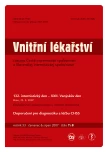Adrenal incidentalomas
Authors:
M. Kršek
Authors‘ workplace:
III. interní klinika 1. lékařské fakulty UK a VFN Praha, přednosta prof. MUDr. Štěpán Svačina, DrSc., MBA
Published in:
Vnitř Lék 2007; 53(7-8): 821-825
Category:
Overview
Adrenal incidentalomas are called as a disease of modern technology because increased availability and accuracy of imaging techniques lead to increased incidence of incidentally discovered adrenal masses. Adrenal incidentalomas are found in about 0.35–4.36 % of abdominal CT scans performed for purpose other than suspicion of adrenal diseases. However, in autoptic studies the percentage of incidentally discovered adrenal tumours in much higher, in some of then being even more than 20 %. Important component of differential diagnosis is endocrinological examination aimed to reveal potential autonomous hormonal overproduction. Approximately more than 10 % of adrenal incidentalomas is characterized by autonomous cortisol production, 5–10 % is phaeochromocytomas and 5–7 % is aldosteron producing adenomas. Vast majority of adrenal incidentalomas are nonfunctioning tumours, mainly adenomas. Rational ways and recommendations for screening of hormonal activity of adrenal incidentalomas is discussed. Very important issue is to distinguish between benign and malignant lesions and between adenomas and non-adenomas. The accuracy of CT, MR, and fine needle aspiration cytology in distinguishing between adenomas from non-adenomas is comparable, in general not exceeding 90 %. Particular characteristics of particular adrenal tumours are discussed. From the relationship between the tumour size and probability of malignancy, current recommendations are derived, that non-functioning tumours smaller than 4 cm are indicated for further follow-up, size over 6 cm is indication for adrenalectomy and in tumours between 4–6 cm decision process is complex.
Key words:
adrenals – tumour – incidentaloma – diagnosis – treatment
Sources
1. Chidiac RM, Aron DC. Incidentalomas. A disease of modern technology. Endocrinol Metab Clin North Am 1997; 26: 233-253.
2. Griffing G. A-I-D-S: The new endocrine epidemic (Editorial comment). J Clin Endocrinol Metab 1994; 79: 1530-1531.
3. Kloos RT, Gross MD, Francis IR et al. Incidentally discovered adrenal masses. Endocr Rev 1995; 16: 460-464.
4. Barzon F, Fallo F, Sonino N et al. Prevalence and the natural course of adrenal incidentaloma. NIH State-of-the Science Conference on Management of the Clinically Inapparent Adrenal Mass („Incidentaloma“), NIH, Bethesda, Maryland, February 4-6, 2002, 27.
5. Mantero F, Arnaldi G. Investigation protocol: adrenal enlargement. Clin Endocrinol 1999; 50: 141-146.
6. Mantero F, Terzolo M, Arnaldi G et al. On behalf of the study group on adrenal tumours of the Italian Society of Endocrinology. J Clin Endocrinol Metab 2000; 85: 637-644.
7. Reincke M. Subclinical Cushing’s syndrome. Endocrinol Metab Clin North Am 2000; 29: 43-46.
8. Kršek M, Hána V et al. Cushingův syndrom. Praha: Galén 2006.
9. Widimský J jr. Mineralokortikoidní hypertenze. In: Marek J et al (Ed). Endokrinní hypertenze. Praha: Galén 2004: 47-70.
10. Pacák K. Nové postupy v diagnostice a léčbě feochromocytomu a pseudofeochromocytomu. In: Marek J et al (Ed). Endokrinní hypertenze. Praha: Galén 2004: 117-160.
11. Kršek M. Náhodně zjištěné tumory nadledvin. Postgraduální medicína. Mimořádná příloha 2006; 20-27.
12. Balk EM. The performance for evaluating incidentaloma. NIH State-if-the Science Conference on Management of the Clinically Inapparent Adrenal Mass („Incidentaloma“). NIH, Bethesda, Maryland, February 4-6, 2002: 35-37.
13. Grumbach MM, Biller BMK, Braunstein GD et al. Management of the clinically inaparent adrenal mass („incidentaloma“). Ann Intern Med 2003; 138: 424-429.
14. Kršek M, Matějovská H. Diferenciální diagnóza incidentalomů nadledvin a úloha zobrazovacích metod. Vnitř Lék 2002; 48: 409-415.
15. Barzon L, Scaroni C, Sonino N et al. Risk factors and long-term follow-up of adrenal incidentalomas. J Clin Endocrinol Metab 1999; 84: 520-526.
Labels
Diabetology Endocrinology Internal medicineArticle was published in
Internal Medicine

2007 Issue 7-8
Most read in this issue
- Hypopituitarism – substitution therapy
- Autoimmune polyglandular syndromes: clinical aspects
- Aspiration cytology of the thyroid
- Randomly discovered enlargement in the region of sella turcica
